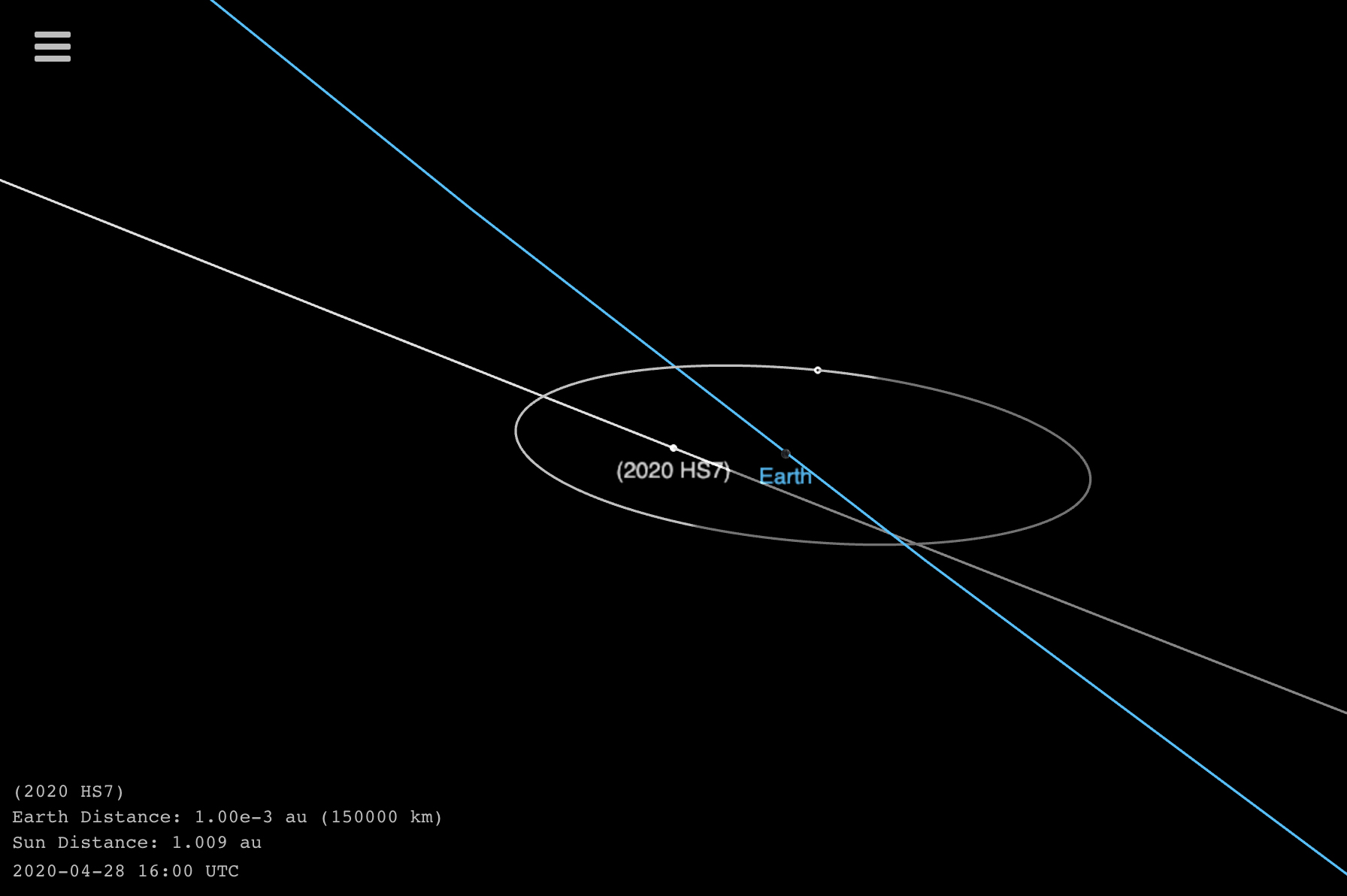Small asteroid zips safely by Earth just ahead of a larger space rock's flyby
A small newfound asteroid gave Earth a close shave today (April 28) on the event of another flyby by a much larger space rock, according to NASA.
The asteroid, called 2020 HS7, is between 13 and 24 feet (4 to 8 meters) in size and passed Earth at a distance of 23,000 miles (36,400 kilometers) when it made its closest approach at 2:51 p.m. EDT (1851 GMT). That range is close to the orbits of some geosynchronous satellites about 22,000 miles (36,000 km) above Earth.
While that sounds close, there was never any risk to our planet, NASA officials said.
"Small asteroids like 2020 HS7 safely pass by Earth a few times per month," NASA's Planetary Defense Officer Lindley Johnson, the program executive for the Planetary Defense Coordination Office at agency's Washington, D.C. headquarters, said in a statement. "It poses no threat to our planet, and even if it were on a collision path with Earth it is small enough that it would be disintegrated by our Earth's atmosphere."
Webcast: See the huge asteroid 1998 OR2 live tonight from Slooh!
Asteroid 2020 HS7's flyby comes just one day before the close approach of a much bigger space rock: the asteroid 1998 OR2. That space rock will pass Earth early Wednesday, April 29, at 5:55 a.m. EDT (0955 GMT).
With a diameter of about 1.5 miles (2 km), asteroid 1998 OR2 is much larger than 2020 HS7, but it's also passing Earth at a much greater distance -- about 3.9 million miles (6.9 million km). That's about 16 times the distance between the Earth and the moon (about 239,000 miles, or 385,000 km).
Breaking space news, the latest updates on rocket launches, skywatching events and more!
Despite its size, asteroid 1998 OR2 is too small and dim to be seen with the unaided eye. But you can see it through telescopes tonight thanks to a webcast from Slooh.com.
The webcast, which you can also see here courtesy of Slooh, begins at 7 p.m. EDT (2300 GMT) and will last an hour.
Scientists at NASA and around the world regularly track asteroids that come close to the Earth in order to identify ones that might one day endanger our planet. These so-called "near-Earth objects" are ones that approach within 4.6 million miles (7.5 million km).
To date, astronomers have discovered 22,776 near-Earth objects, and new ones are being found at a rate of 30 each day, NASA officials said. More than 95% of those objects were found through NASA-funded surveys, they added.
- Mile-long asteroid 1998 OR2 dons 'mask' before Earth flyby (photos)
- About 17,000 big near-earth asteroids remain undetected
- Huge asteroid will zip by Earth April 29. See the latest telescope photos.
Email Tariq Malik at tmalik@space.com or follow him @tariqjmalik. Follow us @Spacedotcom, Facebook and Instagram.
OFFER: Save 45% on 'All About Space' 'How it Works' and 'All About History'!
For a limited time, you can take out a digital subscription to any of our best-selling science magazines for just $2.38 per month, or 45% off the standard price for the first three months.

Tariq is the award-winning Editor-in-Chief of Space.com and joined the team in 2001. He covers human spaceflight, as well as skywatching and entertainment. He became Space.com's Editor-in-Chief in 2019. Before joining Space.com, Tariq was a staff reporter for The Los Angeles Times covering education and city beats in La Habra, Fullerton and Huntington Beach. He's a recipient of the 2022 Harry Kolcum Award for excellence in space reporting and the 2025 Space Pioneer Award from the National Space Society. He is an Eagle Scout and Space Camp alum with journalism degrees from the USC and NYU. You can find Tariq at Space.com and as the co-host to the This Week In Space podcast on the TWiT network. To see his latest project, you can follow Tariq on Twitter @tariqjmalik.


